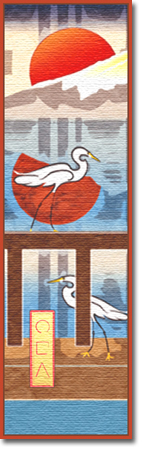On The Way: The Daily Zen Journal
Records of the Source Mirror
Yongming Yanshou (904-976)
Zongjing Lu – Fascicle I
In this Record, I inquire exhaustively into the meaning of mind and investigate the explanations for consciousness. Generally speaking, there are an abundance of interpretations revealing a depth of style, substance, and reasoning. These interpretations lift away the barrier of uncertainty to the door of correct wisdom and chop off the weeds of falsehood in the field of true enlightenment.
To initiate a cure for a chronic disease of the marrow, eliminate the delight taken in clinging to the organs of sense. Then external objects, and the “self” will meet the flames of wisdom-fire, and will be fused together in the cauldron of mind-only. The objectified realm of name and form will face the rays of the wisdom-sun, and will be released into the sea of universal truth.
Since this is, in point of fact, a teaching for inner realization, how can it be explained through textual explanations? The knowledge it unleashes has no limit. What we see and hear through the senses does not reach it.
Now, for the sake of those who have not yet seen this, I explain the “wondrous seeing of no-seeing;” for those who do not yet know it, I talk about the “true knowing of non-knowing;” for those who are not yet liberated, I confirm the “great liberation of non-liberation.”
What I hope is that through the finger you will see the moon, and after catching the hare you will forget the snare, embrace the universal and unite with the implicit truth (zong), discard the explanations, and seek the principle inherent in them, understand that the myriad things depend on the “self” for their existence, and realize that wondrous enlightenment exists in one’s physical body.
It can be described as searching out the deep root of one’s existence, as excavating the cave of principle, as “picking out the marrow from the bones” in the Chan lineage, and as revealing the regulations and guidelines in the network of doctrinal teachings.
To eliminate confusion and erase the stains of one’s karma, perfect purity is ready at hand. The wondrous doctrines of the profound implicit truth advance the notion of the “seeing of no-seeing;” “knowing of non-knowing;” and make them perfectly clear.

With them, you can wear down the mountain built by the seven kinds of arrogance, and bury forever the path built on the six kinds of weaknesses.
The eyes are the mirror of the mind. When the mind-mirror reveals universal truth, all things will appear in it as pristine and void of self-nature. It avoids all kinds of perversities without excluding even the slightest of things.
In their wondrous essence phenomena are devoid of self-nature, and the light of perfection is not alien to them. In the expanse of the infinite, everything reverts to the status of a fleeting appearance.
The appearances adopted by the myriad objects all enter the state of luminosity itself. This is none other than the doctrine of “a single flavor” taught by the sixth patriarch at Caoqi that the various patriarchs have all transmitted. It is the implicit truth of non-duality taught by Shakyamuni at the Crane’s Grove that various scriptures all explain.
The mind-mirror can be referred to as the deep abode of myriad good deeds, the profound origin of all wisdom, the precious ruler of all existence, or the primordial ancestor of the multitude of spiritual beings.
In time, people conceive of a realm of objects separate from the mind. Literary compositions and rational principles are both void; they are illusory objects created by consciousness. The volumes of explanations are proof of this.
The mind-mirror in fact refers to the spiritual abode of living beings and the implicit truth of the myriad dharmas. It is constantly changing in unpredictable ways, expanding and contracting with unimpeded spontaneity. It manifests traces as conditions warrant; names are formed according to the things manifested.
Yongming Yanshou (904-976)
excerpted from Conception of Chan in the Zongjing Lu translated by Albert Welter 2011





This excerpt is scratching the surface of a work consisting of 100 fasicles; the above being only part of the first fasicle and the only one in translation at this point. Even in this brief glimpse, one can get a sense of the intention behind the work.
Since there are sutras too numerous to count, Yanshou is taking the gems from many of them to help essentialize the heart of Buddhism. Anyone who has attempted to read a sutra in its entirety can feel like the literary style of hundreds of years ago and many cultural iterations away from ours make true understanding very difficult.
One can also appreciate the balance of practice and study; they both go hand in hand. When you appreciate how many years the sutras were memorized and transmitted verbally, it is truly a gift to have a written form of them, and more importantly a master who is intent on keeping them alive for us.
This is a serious study and not always easy to digest, but many readings and pausing can start to soften the message. When we try to meet him more than halfway rather than feeling overwhelmed by the expression, there are jewels contained therein.
If you feel right on the verge of understanding, right at the edge of the cliff, hearing the thunder warning of the storm to come, just know we are right where we should be, close to the heart of the matter. Comfortably close…
With Care,
Elana, Scribe for Daily Zen